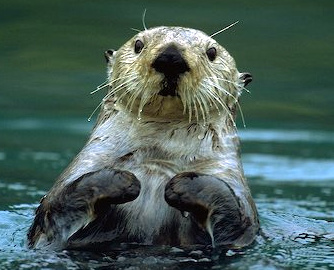While some people think of sea otters as adorable tourist attractions, others see them as predators in fierce competition for valuable shellfish like abalone, Dungeness crabs and geoducks.
Marine mammal biologist Dr. Heidi Pearson is interested in learning more about how sea otter feeding habits may be changing the ecology of Sitka Sound. Pearson is a newly appointed Assistant Professor of Marine Biology at the University of Alaska Southeast Juneau. Pearson believes that by feeding on sea urchins, otters stabilize the kelp forests. Without otters to keep them in check, urchins act like spiny lumberjacks by gnawing through the stalks that connect kelp to the sea floor.
So Pearson suspects that the kelp forests in Sitka Sound are in good shape in part because of sea otters.
“The kelp forests could be healthier because the sea otters are here and keeping that sea urchin grazing pressure low. And then the kelp forests of course in turn provides habitat for other species such as some fish.”
Sea otters have an interesting history in Alaska. Starting in the 1700s, the Russians hunted them for their pelts. By 1911 there were no more sea otters left in Southeast Alaska, with the closest remnant population in Prince William Sound.
In the 1960s The Alaska Department of Fish and Game reintroduced them in six locations around the panhandle. Nearest to Sitka was a release of 48 sea otters at Biorka Island in 1968. Since then, their populations have expanded from those six locations. They now occupy continuously the outer coast of Southeast as well as parts of Frederick Sound, Icy Strait, and Glacier Bay.
As far as Pearson knows, there has been no formal research on the impact sea otters are having on other species in Sitka Sound. This summer, the first step will be mapping the habitat where sea otters are feeding. Pearson will be working with Sitka-based University of Alaska Southeast marine mammal researcher Jan Straley.
Also on the project is graduate student Kierstin Barlow. Barlow is a fourth-year marine biology major at the University of Alaska Southeast. She’ll be conducting the research out of Straley’s university laboratory at the Sitka Sound Science Center — observing otter populations and mapping kelp. Barlow is looking forward to the field research experience.
“Any opportunity to work with marine mammals I jump on.”
Meanwhile, Pearson has plans to continue mapping habitat in otter-free areas, like Juneau.
“If we can characterize the habitat in areas where there aren’t sea otters now and then sea otters move in we would have a great kind of before and after natural experiment to see how sea otters are changing the habitat.”
Knowing the kind of habitat otters prefer in Sitka Sound and how much of it is available around Juneau might help Pearson and Straley predict where otters are likely to show up next. The results of this research could have important implications for the whole ecosystem – including even tourists.
Ellen Chenoweth is a PhD student at the University of Alaska Fairbanks studying fisheries. This summer, as part of a fellowship with MESAS (Marine Ecosystem Sustainability in the Arctic and Subarctic), she is exploring science journalism under the mentorship of the Sitka Sound Science Center and KCAW. MESAS aims to prepare students to combine natural sciences like biology and geology with social sciences like anthropology, political science, and economics to find long-term solutions to ocean problems.
































